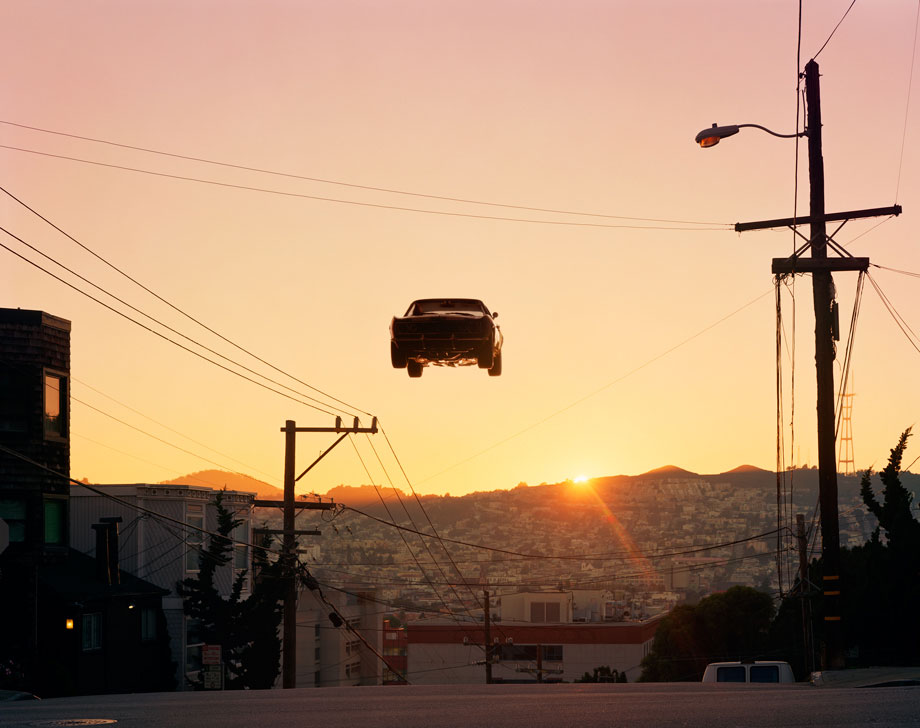We’re back-tracking here; the FotoFocus opening week-end is just past us. But the Biennial continues through November 1st; and I encourage anyone in the vicinity of Cincinnati (or really anywhere in the Ohio or northern Kentucky area) to take in whatever exhibitions and events are currently running or soon to open. (Check the FotoFocus website at www.fotofocusbiennial.org for information and calendar/scheduling updates.)
One of the ‘foci’ that seemed to emerge from this edition of FotoFocus was the transition from still to moving image; and the process of the transition itself—the process, the moment-to-moment ellipsis, the sustained impact, and the trace or record of that impact as documentary (physical) fact and as memory.
One of the first shows I saw here was the Stills show, at the Michael Lowe Gallery, curated by FotoFocus Artistic Director Kevin Moore and curator/collector/publisher Nion McEvoy, in which a number of photographs or configurations of photographs were arranged as if clipped from a 16-mm or 35-mm film or film strip. John Waters’ “Inga #3 (1994), which more or less takes ‘Inga’ from the prurient gaze (or just the title) to orgasm in six frames (C-prints of course), faced off against the outstanding “Line of Fate” (2011) by Tacita Dean (famed for her work in 16-mm film), in which a hand ‘writes’ across the page of a notebook in five photographs—with a ‘blink’ registered as a color photograph in the sequence. Even for the single large format photograph (e.g., Matthew Porter’s photographs of automobiles airborne over the streets of Los Angeles), the single image was not enough. Moore showed six of the magic-light/big-sky horizoned images in the show, with the atmospheric—and time—variations beautifully and subtly defined by the rich pigment print color. If you held a smart phone up to John Stezaker’s “Crowd” (2013), you might take home a single perfect frame out of the 384 that would have whizzed by. (Other artists included Barbara Probst, Ryan McGinley, Talia Chetrit, Daniel Gustav Cramer, Paul Graham, Moyra Davey and Taryn Simon.
From the Stills show, we jumped to the Lightborne Studios, a beautifully designed production and design facility on 14th Street in the Over-the-Rhine section of Cincinnati, with screening rooms (for both in-house and exhibition), for Kevin Moore’s curated Screenings—films and video/digital moving image paired off in variably thematic, dramatic or formal dialectics, my view of which was somewhat abbreviated, moving from screening room to screening in an afternoon that went by far too quickly. Under the rubric, “Others,” for example, Moore ‘cast’ two peripatetic narratives in which the protagonist figures proceed through a kaleidoscopic sequence of exteriors and interiors, with alternately subtle and emphatic shifts in tone and dramatic possibility. The ‘Others’ here were Julian Rosefeldt’s Lonely Planet (2006) and Rosalind Nashashibi’s This Quality (2010). The first might have taken its breezy tone from the guide books by the same name, tracking its subject’s sinuous steadi-cam trek through desert and bazaar, city streets, and a river quickly revealed as the Ganges, and through slightly stereo-typical Indian situations, culminating in a (well-filmed/edited) Bollywood production. Of the two, the far more interesting, though, was the Nashashibi film, with its shimmer of scrimmed/screened and filtered images, secrecy and exposure, concealment and disclosure; veils and walls juxtaposed against an almost tactile reveal—fascinating.
The “Performances” offered essentially theme-and-variations (almost literally) by way of Rainer Ganahl’s 2013 Performances (classical music performances in a distinctly down-market and slightly disheveled discount store setting), and Moyra Davey’s Les Goddesses (2011), a meditative meandering over Mary Wollstonecraft’s life and legacy. The other films were by Slater Bradley, Wilhelm Sasnal, Len Lye, Martha Colburn, Bruce Conner, Jack & Leigh Ruby, and Peter Roehr, whose hypnotic, montage of oddly compelling, troubling clips from mostly American television commercials (a golden age of the form), stuttering at us in rapid-fire succession, made for disturbing mental after-images and after-thoughts. Several of us (visiting journalists) found ourselves talking about his film for some time afterward. Bradley’s Loves (owing much to Chris Marker), Sasnal’s Mojave and Colburn’s I’m Gonna were also excellent.


